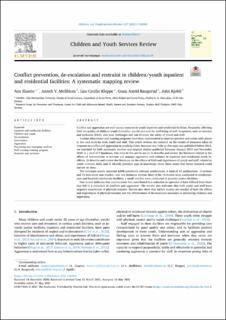| dc.contributor.author | Slaatto, Ane Jacobsen | |
| dc.contributor.author | Mellblom, Anneli | |
| dc.contributor.author | Kleppe, Lise Cecilie | |
| dc.contributor.author | Baugerud, Gunn Astrid | |
| dc.contributor.author | Kjøbli, John | |
| dc.date.accessioned | 2021-06-04T10:17:03Z | |
| dc.date.available | 2021-06-04T10:17:03Z | |
| dc.date.created | 2021-05-27T10:23:31Z | |
| dc.date.issued | 2021-05-21 | |
| dc.identifier.citation | Children and Youth Services Review. 2021, 127, (1-10). | en_US |
| dc.identifier.issn | 0190-7409 | |
| dc.identifier.uri | https://hdl.handle.net/11250/2757800 | |
| dc.description.abstract | Conflict and aggression are well-known concerns in youth inpatient and residential facilities, frequently affecting both the quality of youth care and the well-being of staff. Responses, such as restraint and seclusion (R&S), also pose challenges and can threaten the safety of children/youth and staff. Various educational and training programs have been implemented to improve practice and create safer places to live and work for both youth and staff. This article reviews the research on the results of measures taken in response to conflict and aggression in youth facilities. Because very little on this topic was published before 2015, we searched for both systematic reviews and original studies published between January 2015 and November 2020 in a total of 7 databases. Our aims in this article are to 1) describe and review the literature related to the effects of interventions to prevent and manage aggression and violence in inpatient and residential youth facilities, 2) describe and review the literature on the effects of R&S and experiences of youth and staff, related to youth violence, R&S, and 3) identify potential gaps in knowledge about these issues that future research could narrow or close. The literature search retrieved 4,698 potentially relevant publications. A total of 14 publications—2 reviews and 12 individual case studies—met our inclusion criteria. Most of the 14 studies were conducted in residential-care and hospital/psychiatric facilities; a small number were conducted in juvenile justice facilities. Our review indicates that interventions that contributed to a reduction in episodes of seclusion and restraint differed from those that led to a reduction in conflicts and aggression. The review also indicates that both youth and staff have negative experiences of physical restraint. Results also show that further studies are needed of both the effects and experiences of physical restraint and the effectiveness of de-escalation measures in preventing violence and aggression. | en_US |
| dc.language.iso | eng | en_US |
| dc.publisher | Elsevier | en_US |
| dc.relation.ispartofseries | Children and Youth Services Review;volume 127 | |
| dc.rights | Navngivelse 4.0 Internasjonal | * |
| dc.rights.uri | http://creativecommons.org/licenses/by/4.0/deed.no | * |
| dc.subject | Inpatient facilities | en_US |
| dc.subject | Residential facilities | en_US |
| dc.subject | Children | en_US |
| dc.subject | Youths | en_US |
| dc.subject | De-escalations | en_US |
| dc.subject | Interventions | en_US |
| dc.subject | Aggressions | en_US |
| dc.title | Conflict prevention, de-escalation and restraint in children/youth inpatient and residential facilities: A systematic mapping review | en_US |
| dc.type | Peer reviewed | en_US |
| dc.type | Journal article | en_US |
| dc.description.version | publishedVersion | en_US |
| dc.rights.holder | © 2021 The Author(s). | en_US |
| dc.source.articlenumber | 106069 | en_US |
| cristin.ispublished | true | |
| cristin.fulltext | original | |
| cristin.qualitycode | 1 | |
| dc.identifier.doi | https://doi.org/10.1016/j.childyouth.2021.106069 | |
| dc.identifier.cristin | 1912152 | |
| dc.source.journal | Children and Youth Services Review | en_US |
| dc.source.volume | 127 | en_US |
| dc.source.pagenumber | 1-10 | en_US |
| dc.relation.project | Norges forskningsråd: 299944 | en_US |
| dc.relation.project | Barne-, ungdoms og familiedirektoratet (Bufdir): 20286 | en_US |

